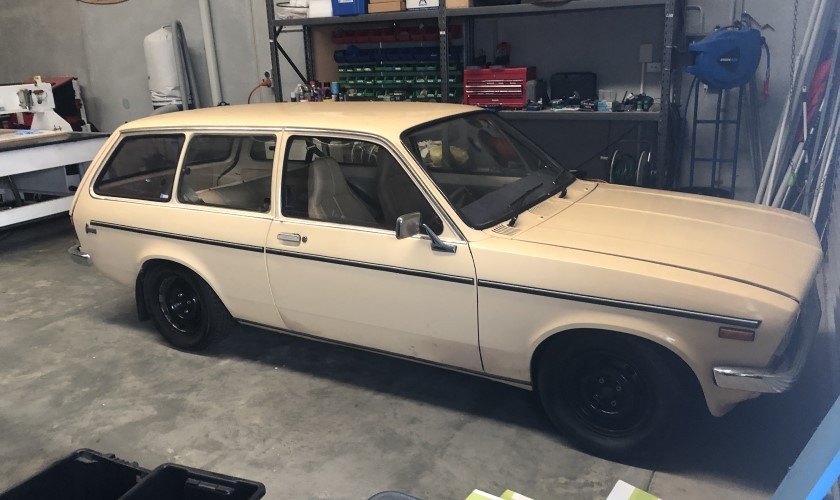DIY Electric Vehicle - 1979 Gemini Wagon
Would you believe this whole exercise started after my home electrical wall was built? It seemed like the next logical step in the process. Harvest energy from the sun, store it in my DIY power wall, then charge an electric vehicle with said stored energy. It makes sense yeah? Well, the Power Wall has been up and running for over a year and I've made little headway in the DIY electric vehicle (EV) game.
Donor vehicle So many choices! But the vehicle had to meet a few criteria. The first being the “weight” of the vehicle. No need to choose a super heavy vehicle and try to push it with an electric motor. The donor had to be light.
So many choices! But the vehicle had to meet a few criteria. The first being the “weight” of the vehicle. No need to choose a super heavy vehicle and try to push it with an electric motor. The donor had to be light.
The second criterion was the type of transmission and gearbox. I opted for a rear wheel drive manual vehicle. By far the simplest conversion is fitting an electric motor directly to the manual gearbox. It may not be the most efficient, but using the gearbox, flywheel and clutch we have a manual electric motor disconnect, and for me having that safety disconnect is a selling point important when using this method. Press the clutch and the electric drive is disengaged. Some enthusiasts will say a direct connection to the gearbox input shaft is just as good and say it's more efficient, but being a DIY build I think the safety outweighs the efficiencies that I can lose.
So which vehicle could we have chosen? A popular choice is the VW Beetle, you can buy kits to bolt them on straight away. likely conversion within a day if you had the right tools. However, I wanted something different. I've always loved the Gemini scene here in Australia, some of the turbo racing Geminis go pretty hard. I ended up settling on this little "Grandma Spec" TD wagon. I chose the wagon as I felt it fit the criteria, loads of rear space for some batteries and the total weight of the car is around 900kg. Nice and light! It is also rear-wheel drive with a manual transmission.
Tear downTo keep it short and sweet, the disassembly was actually the easy part. Say goodbye to some of the major offending components. The combustion engine, fuel tank, exhaust and associated components. For now, I'm keeping the brake system and as many original accessories as possible. The idea will be to keep running a 12v battery to run much of the original electricity. This will help come during approval/engineering time. Check out the gallery below for some before and after shots.
Choice of electric motor
Each type of motor has advantages and disadvantages depending on its use. There are WAY too many factors to discuss in this blog post to explain why one is better than the other. However, we can discuss which vehicles currently have what. The Tesla Model S is probably the best example of this and uses an AC induction motor. We can assume that you get high performance with this type of engine. We can also assume that it has a cost! You will find DC Brushless motors in e-bikes and skateboards. A little cheaper, but maybe not as effective when pushed harder...

Would you believe this whole exercise started after my home electrical wall was built? It seemed like the next logical step in the process. Harvest energy from the sun, store it in my DIY power wall, then charge an electric vehicle with said stored energy. It makes sense yeah? Well, the Power Wall has been up and running for over a year and I've made little headway in the DIY electric vehicle (EV) game.
Donor vehicle So many choices! But the vehicle had to meet a few criteria. The first being the “weight” of the vehicle. No need to choose a super heavy vehicle and try to push it with an electric motor. The donor had to be light.
So many choices! But the vehicle had to meet a few criteria. The first being the “weight” of the vehicle. No need to choose a super heavy vehicle and try to push it with an electric motor. The donor had to be light.
The second criterion was the type of transmission and gearbox. I opted for a rear wheel drive manual vehicle. By far the simplest conversion is fitting an electric motor directly to the manual gearbox. It may not be the most efficient, but using the gearbox, flywheel and clutch we have a manual electric motor disconnect, and for me having that safety disconnect is a selling point important when using this method. Press the clutch and the electric drive is disengaged. Some enthusiasts will say a direct connection to the gearbox input shaft is just as good and say it's more efficient, but being a DIY build I think the safety outweighs the efficiencies that I can lose.
So which vehicle could we have chosen? A popular choice is the VW Beetle, you can buy kits to bolt them on straight away. likely conversion within a day if you had the right tools. However, I wanted something different. I've always loved the Gemini scene here in Australia, some of the turbo racing Geminis go pretty hard. I ended up settling on this little "Grandma Spec" TD wagon. I chose the wagon as I felt it fit the criteria, loads of rear space for some batteries and the total weight of the car is around 900kg. Nice and light! It is also rear-wheel drive with a manual transmission.
Tear downTo keep it short and sweet, the disassembly was actually the easy part. Say goodbye to some of the major offending components. The combustion engine, fuel tank, exhaust and associated components. For now, I'm keeping the brake system and as many original accessories as possible. The idea will be to keep running a 12v battery to run much of the original electricity. This will help come during approval/engineering time. Check out the gallery below for some before and after shots.
Choice of electric motor
Each type of motor has advantages and disadvantages depending on its use. There are WAY too many factors to discuss in this blog post to explain why one is better than the other. However, we can discuss which vehicles currently have what. The Tesla Model S is probably the best example of this and uses an AC induction motor. We can assume that you get high performance with this type of engine. We can also assume that it has a cost! You will find DC Brushless motors in e-bikes and skateboards. A little cheaper, but maybe not as effective when pushed harder...
What's Your Reaction?















![Three of ID's top PR executives quit ad firm Powerhouse [EXCLUSIVE]](https://variety.com/wp-content/uploads/2023/02/ID-PR-Logo.jpg?#)







